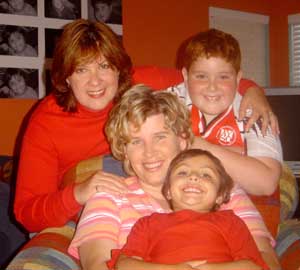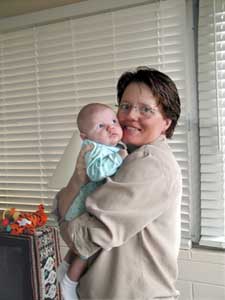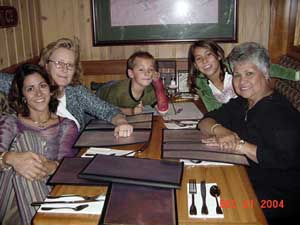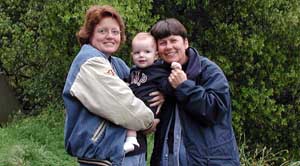feature
The secret ingredient of lesbian motherhood
Conversations with toddlers about the facts of life
Published Thursday, 05-May-2005 in issue 906
A child conceived through the love of two women, a sperm donor, a pocket book and the drawing up of several legal documents must be the luckiest of all.
Not only are the mothers of these children comforting and loving, but they are sort of like superheroes. These mothers wear the red cape of super- activist lore. They are instantaneous educators. They influence the lives of everyone on the playground, at the park and in the schools. They are a constant reminder that society is based on social construction and proof that life is not stagnant.
These mothers have the ability to conjure new vocabulary to describe relational roles; recreating years of anthropological diagrams. They have within their possession an entire extended family of rainbow-colored “aunties,” both male and female; creating a community most likely built on tolerance and compassion.
They hold within their power the ability to make or break the very standards by which society conducts its business.
Not getting too far ahead of themselves, these mothers must also know that within their hands rests the delicate egos of these children, who although surrounded by love and protection, are still vulnerable to the ugliness of homophobia and a society that holds little compassion for difference. It is up to these super-moms to build a foundation of truth and understanding that will lead these lucky children on a path to healthy self-esteem and a sense of purpose.
The Gay & Lesbian Times interviewed three local lesbian-headed households, each raising children conceived by the use of donor sperm. We learned a lot about what to say and what not to say when a child of a donor parent finally asks about his/her birth origin, and a little something extra about secret potions, special ingredients and meat in a can.
“Zane looked up at him and said ‘I know you’re my ingredient dad and I know what ingredient you gave to make me… SPERM!’” The first family, local lesbians Amy and Michelle Besnoy, are raising two children together – Zane and Izak. Though Izak is still an infant and not yet grappling with the concept of genetics and reproduction, Zane was about 2 1/2 years old when he first became curious about his origins. He wanted to know whether or not he had a dad.
“I responded that everyone has a dad,” Amy recalled. “Some dads live with their kids and are ‘decision dads’ because they make decisions about the kids in day to day [situations], and I gave an example of someone we know. Then I said that some dads help their kids be made and are ‘ingredient dads.’
“‘You have an ingredient dad,’ I said.
“He asked who it was. I told him. His response was ‘Do I know that guy?’
“He did. In fact, he had seen him several weeks before, although a photo was needed to show him who I meant.
“The ingredient analogy made sense to him at the time. We were doing a lot of cooking together and he understood the idea of mixing ingredients to make something.”
A few month’s later, Zane came into contact with his “ingredient dad.”
Amy continued, “Zane looked up at him and said ‘I know you’re my ingredient dad and I know what ingredient you gave to make me… SPERM!’”
Honesty is certainly the best policy when dealing with children of donor fathers in lesbian households, according to Heidi Quiroz, adoption program manager at San Diego County Adoptions. She emphasized the importance of being honest with the child and finding age-appropriate language to explain the child’s birth origins.
“Whether the child is adopted or was born from a sperm donor, it is important to talk about who the child is, who their birth parents are and the circumstances around their birth and how they came to live with their current parents,” she said. “The child’s history should never be a kept a secret, and the parents must show that they are comfortable with the arrangements of the child’s birth in order to portray normalcy onto the child and his or her life.”
“Sometimes they will brag, ‘I have two Moms and you only have one!’” She explained that around the age of 3 or 4, children begin to understand the concept of reproduction – such as noticing that pregnant women have babies growing inside their “tummies.” She suggests using the sight of a pregnant mother to bring up the idea of conception and the child’s own birth origin. Using photo albums and scrapbooks is also helpful to describe and document the child’s unique history, she said.
“For sperm donors, often the parents raising the child have no more than characteristic information about the sperm-donor parent,” Quiroz continued. “This information is just as important for the child to know, as would any identifying information. As children grow and begin to understand more developmentally, they will want to know more about their birth parent: What did they look like? What kind of work did they do? Were they good at sports? Why didn’t they want me?
“If the family has kept open and honest communication going as the child develops, they will feel comfortable asking these questions and will have a better sense of who they are.”
According to an article entitled, “Talking to children about their adoption: when to start, what to say, what to expect,” printed in the June 2000 edition of Adopted Child, children don’t always pick the most convenient times to ask about their history.
“Children often pick awkward, public moments to ask where they came from. They often treat the answer matter-of-factly, turning their attention back to whatever activity they were engaged in, and leaving parents wondering if they answered ‘correctly,’” writes the editor, Lois R. Melina.
Judy and Pepper Lane’s son Cory was also about 2 1/2 years old when he started asking questions about his birth origin. The mothers explained that he was conceived with a “secret potion” – a concept he understood as he was into creating potions from ingredients in the kitchen cabinets. Later, the two moms were able to see how well he really understood his situation.
“One day we were returning from a trip to San Francisco …and riding a packed shuttle bus to the parking lot,” Judy said. “Cory struck up a conversation with a little boy traveling with his mom and dad, and was seated next to them at the back of the bus, while Pepper and I stood hanging on the handrails somewhere midway.
“We – along with everyone on the shuttle – were watching and smiling adoringly. When he noticed us watching, he lowered his head and suddenly got shy. ‘I’m sorry,’ I said. ‘You’re embarrassed.’
“So, Pepper and I turned away to give him his space. They resumed the conversation and the other boy kept referring to his dad – ‘My dad this and my dad that.’
“Just then Cory blurts out at full volume, ‘I don’t have a dad. My moms got the secret potion from the man and that’s how I got here.’
“Everyone on the bus whipped their heads to catch our reaction just as the boy’s dad calls out, ‘And now who’s embarrassed?’ We all just roared.”
According to Melina, the stories of conception and/or adoption “have as much tension and dramatic plot twists as a cinematic thriller.”
“As children grow and begin to understand more developmentally, they will want to know more about their birth parent: what did they look like? What kind of work did they do? Were they good at sports? Why didn’t they want me?” She writes, “For parents to not talk about adoption with a young child requires that they not tell one of the most dramatic stories of their family history. For most people this would be unnatural and require constant vigilance. Even young children are likely to sense the discomfort in the family when parents have to be ‘on guard’ not to tell this part of the family story unintentionally. More important, if sharing stories about the family history is an essential part of feeling close as a family, parents who do not talk about their children’s adoptions may be inhibiting that sense of commonality.”
The three families agree with this theory when applied to their own situations. They all said they believed in being completely honest with the children, no matter how awkward or how young they started inquiring about their birth circumstances.
Besides being open and honest with the children, the article, “Differentiating between secrecy, privacy, and openness in adoption,” printed in the May 1993 issue of Adopted Child, also notes that it is important for families to keep check of personal boundaries.
The author notes, “In human relationships, too much candidness can leave us feeling vulnerable and exposed. Though society has become increasingly willing to talk about subjects once considered taboo, there are still matters too personal to share with everyone.
“Clearly, harmful secrecy and defenseless openness are extreme manners of dealing with information that carries some emotional risk.”
The author suggests allowing for “situation judgments about whether revealing information will leave us unnecessarily vulnerable, whether disclosing facts is appropriate and about to whom the information is relevant.”
One family explained that although they are open about their child’s conception, for the sake of this article, they would like to assert their ability to set boundaries of privacy for their son’s best interest. For this reason, they asked to remain anonymous. We will call them Tiffany and Carmen Renoir, a local lesbian family raising three children.
The Renoirs’ middle child, “Douglas,” was conceived through intra-cervical insemination at home with sperm from a known donor. The family is in contact with the donor, who is known as “Uncle” to Douglas. Around the age of 4, Douglas began to ask questions about his origin. Tiffany explained that “Uncle” helped “make him.”
He was at first upset and responded, “I don’t want to be cooked,” thinking Uncle had somehow concocted him in the kitchen. He was relieved to know he wasn’t actually going to be cooked. A few years later, Tiffany and Carmen were able to see how the information had manifested in their son. Douglas and “Timothy,” Uncle’s 8-year-old son, were discussing donor relationships and insemination.
Tiffany said, “Timothy asked Douglas if he knew what sperm is. Douglas said, ‘Of course. It’s meat in a can.’
“Once I clarified the difference between Spam and sperm, they went on to speculate about how we got the sperm inside mommy,” she said.
“They came up with some wild ideas involving straws, physics and complicated circus contortions. Fortunately they were satisfied with their imaginations, and I was able to leave that one alone.”
Unlike Douglas, many children of lesbian parents are conceived by use of anonymous donors. Though Quiroz said she believes families should be completely honest with the children from the get-go, she also believes it’s important to not tell a child they will never meet a birth parent, as the future is not yet determined.
She explains that even children brought up in the most honest and loving environment may still feel loss or grief that a birth parent is absent from their life.
“As a child grows, their understanding matures and they address new issues around their birth history,” she said. “Adopted teenagers, like most teenagers, are concerned with who they are and focus on their identity. This is when it is especially important for parents to continue to provide the information that they know about the birth parent with the child.
“They want to know more about who they look like and where they fit in. This is especially difficult in situations where there is an unknown birthparent.
“The child’s sense of loss and confusion around their identity may, at times, result in anger and resentment. The anger may be towards their birth parent, their adoptive parents or towards themselves. Children and teens who appear to be excessively sad or angry and who have trouble coping with their story may need professional help. Professional counseling, both individual and family, can be effective. Support groups for children who are experiencing the same issues around adoption are also effective.”
Melina concurs that openly communicating with children is essential to their growth and self-esteem.
“Rather than trying to protect their children from emotional anguish, it is the parents’ job to help their children learn how to process and cope with distressing feelings,” she said.
For those children who are struggling with their identity or birth situation, San Diego County contracts with San Diego Youth & Community Services to provide adult support groups, respite, family gatherings and counseling. The GLBT parenting group Family Matters also provides several support groups and activities for San Diego families.
Aside from group therapy and family counseling, Melina recommends journaling, poetry and creating rituals as other methods to help children learn how to cope with their unique family circumstance.
Quiroz said that it is important to “let the child ask questions and process the answers they are given.” She said it is important to validate their feelings and to expose them to other children with similar histories. This will also help prepare the children to deal with societal homophobia and pressure from their peers to fit in. The three families interviewed all said they had positive experiences with children the same age as their children, as well as with reactions to their family structure.
The Lanes said that their younger daughter has yet to ask questions about her birth origin and that other children at school have been mostly accepting of their unique family structure. In fact, Judy said, “Kids ask and my children answer honestly, ‘I don’t have a dad. I have two moms,’ and the kids accept it.
“I think it has everything to do with the comfort level that my kids feel about who they are. They don’t think it’s odd, so they react as if this is the way it’s supposed to be, for them anyway, and the other kids respond accordingly,” Judy said. “Teachers have told us how amazing this is because of how our children handle it when kids ask.”
She added, “Sometimes they will brag, ‘I have two moms and you only have one!’”
Amy Besnoy said her children also brag about their family situation.
“The [other] kids seem to take it in stride when he [Cory] says ‘I’ve got four moms.’” Cory’s other legal parent lives in the Bay Area with her new partner.
Judy added, “Often the response is ‘Wow, that’s a lot of moms.’
“Adults have a harder time wrapping their heads around the concept,” she noted.
The Renoirs’ eldest child, who is a teenager, has been teased a few times about her family and asked inappropriate questions about her mothers’ sex life. But, says Tiffany, most of the negativity her family has experienced has come in the form of “anti-gay comments that are a daily part of many school children’s vocabulary.”
She explained that strangers at times act out with confusion and/or ignorance, but are not usually outwardly hostile. “Sometimes people ask questions to try and figure out who is who, especially as we are of different ethnic backgrounds as well,” she said. “For example, Carmen has been asked if she’s the nanny (when our oldest daughter was young) and I have been asked if I’m Douglas’ grandmother.”
Tiffany explained that she and her partner like to revisit the issue of their children’s parentage, even when the children do not bring it up themselves. “We want to let the kids know that we know some people say mean things about gay people, and it won’t hurt our feelings if they tell us about it,” she said. “When people do and they [the children] feel bad, we want to know about it so we can give them an extra hug and talk about it.”
Judy Lane said her family has also never really experienced open hostility toward her family.
“In our 18 years of being together, I honestly can’t think of anyone who has been outwardly hostile towards us, and we have lived in very conservative communities,” she said. “Generally, we have found that people react to you as a person. The more comfortable you are with who you are, the more they are. We are by nature very friendly and open people, and we both have a good sense of humor, as do our kids.
“Most people have just never actually had the opportunity to know a gay family, so their fear/ignorance comes from not knowing – or at least they don’t think they do, anyway.
“We have had several people tell us that because they knew us, they were much more optimistic when their son/daughter came out to them. Realizing that our lives are pretty much like theirs helped them to accept their children’s lifestyles. It gets a little different when you’re dealing with parents, since they have not quite figured out how to tell their children about people who are different from them, so you just have to be open and patient.
“We make ourselves known to the parents of our kids’ friends. That way, there are no surprises and they see that we’re pretty normal,” she said, with tongue in cheek.
Ultimately, being real and honest and defining family from love, not just tradition, seems to be the secret ingredient to making lesbian parenthood work.
Quiroz shared an anecdote about one of her clients – a single, white father of two adopted boys – one white and one of possibly African-American descent – and his commitment to defining family. In this case, the ingredient was not sperm, but solidarity.
“One day, I was visiting with the family at a park,” Quiroz said. “Some kids that were playing with the child came up and persistently asked the adoptive father if the child’s dad was black. Finally, the dad answered ‘Yes, we have African-American ancestry in our family. And if you would like to know more about his birth father, ask him [the child].’
“I thought this was a wonderful response,” she explained. “By saying ‘we have African-American ancestry’ he gave the message that the ‘we’ is their family, and that the child and his ancestry were included in the ‘we.’
“His answer was open, honest and non-judgmental, and everyone was comfortable. Because the father had always been open and honest about the child’s paternity, the child had normalized his situation and was not shocked or uncomfortable with the answer.”
While there is obviously no recipe book or true secret potion or ingredient to help define, describe or explain lesbian parenthood and the means of conception, love, honesty, a sense of humor and an open mind seem to leave the best taste.
|
|
Copyright © 2003-2025 Uptown Publications










